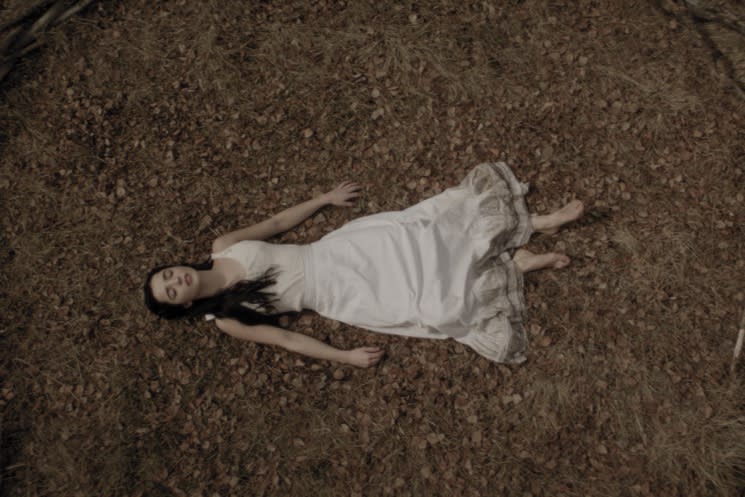The Curse of Audrey Earnshaw is moody, stark and totally on-vibe for spooky season — but that's about it. Directed by Thomas Robert Lee, this folk-horror flick is beautifully shot with impressive set design, but lacks in the substance needed to become a stand-out of the genre.
Agatha Earnshaw (Catherine Walker) lives on the outskirts of her remote Irish Protestant village in 1973, where she hides her mysteriously powerful daughter Audrey (Jessica Reynolds) from the community. When a seemingly supernatural pestilence destroys the community's crops and livestock, the town begins to suspect the Earnshaws of witchcraft, as their farm remains virtually untouched.
Reminiscent of rave horror classics like Robert Eggers' The Witch or Joko Anwar's Impetigore, where the themes of witchy folk-horror and intergenerational curses have been done spectacularly well, The Curse of Audrey Earnshaw attempts to live up to the hype — and stumbles. The film opens with a rolling screen prologue, which immediately sours the tone. Film is a visual genre, one that is meant to show, not tell. The choice to force your audience to read the background of your story is a cheap one. Once in a while there's a decent performance — Hannah Emily Anderson (playing Bridget Dwyer) specifically stands out, but the majority of high-drama scenes play as comedy.
The major plotline of the film begins when Audrey is accidentally spotted by a couple of local villagers, and the young girl is, well, lusted after? Her satanic powers apparently include a somewhat siren-esque ability to lure in men in order to convince them to sell themselves to the devil. The movie never addresses Audrey's age, so we could assume the young woman is over 18, but the lack of confirmation makes those scenes extremely uncomfortable to watch.
Following multiple aggressive interactions between Agatha and the locals, Audrey begins rebelling from her mother's restrictions and exacts revenge on the community — where we then flip-flop between different crumbling families as they deal with the ramifications of Audrey's curses. Each family suffers a different fate, but while the prologue of the film described rapid pestilence amongst the entire community, we're left empty-handed as only the few that tormented Agatha personally seem to suffer any sort of plague. The Curse of Audrey Earnshaw needs to move a few steps back. The lighting and atmosphere deserve recognition, and the gore/prosthetics are bloody, gross and realistic — but the lacklustre performances and stumbling plot ultimately turn a promising project into a disappointment.
(Gate 67)Agatha Earnshaw (Catherine Walker) lives on the outskirts of her remote Irish Protestant village in 1973, where she hides her mysteriously powerful daughter Audrey (Jessica Reynolds) from the community. When a seemingly supernatural pestilence destroys the community's crops and livestock, the town begins to suspect the Earnshaws of witchcraft, as their farm remains virtually untouched.
Reminiscent of rave horror classics like Robert Eggers' The Witch or Joko Anwar's Impetigore, where the themes of witchy folk-horror and intergenerational curses have been done spectacularly well, The Curse of Audrey Earnshaw attempts to live up to the hype — and stumbles. The film opens with a rolling screen prologue, which immediately sours the tone. Film is a visual genre, one that is meant to show, not tell. The choice to force your audience to read the background of your story is a cheap one. Once in a while there's a decent performance — Hannah Emily Anderson (playing Bridget Dwyer) specifically stands out, but the majority of high-drama scenes play as comedy.
The major plotline of the film begins when Audrey is accidentally spotted by a couple of local villagers, and the young girl is, well, lusted after? Her satanic powers apparently include a somewhat siren-esque ability to lure in men in order to convince them to sell themselves to the devil. The movie never addresses Audrey's age, so we could assume the young woman is over 18, but the lack of confirmation makes those scenes extremely uncomfortable to watch.
Following multiple aggressive interactions between Agatha and the locals, Audrey begins rebelling from her mother's restrictions and exacts revenge on the community — where we then flip-flop between different crumbling families as they deal with the ramifications of Audrey's curses. Each family suffers a different fate, but while the prologue of the film described rapid pestilence amongst the entire community, we're left empty-handed as only the few that tormented Agatha personally seem to suffer any sort of plague. The Curse of Audrey Earnshaw needs to move a few steps back. The lighting and atmosphere deserve recognition, and the gore/prosthetics are bloody, gross and realistic — but the lacklustre performances and stumbling plot ultimately turn a promising project into a disappointment.
